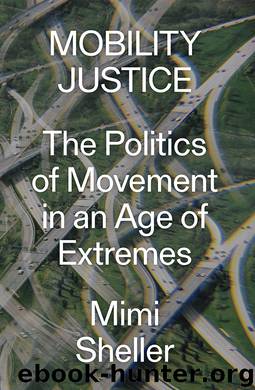Mobility Justice by Mimi Sheller

Author:Mimi Sheller
Language: eng
Format: epub
Publisher: Verso Books
DISASTER (IM)MOBILITIES
While everyday situations are important, sometimes more extreme events can help reveal some of the usually hidden actions of infrastructural space, including their repair and maintenance in the face of disruption.30 Natural disasters bring to the fore the astounding interdependence and fragility of the complex mobility systems and infrastructural moorings that make up contemporary cities, regions, and transnational geographies of planetary urbanization. How do questions of mobility justice play out in these messy post-disaster situations?
Recent approaches to the geography of disasters and post-disaster recovery emphasize how prior distributions of advantage and disadvantage lead to uneven reconstruction and redevelopment, often exacerbating preexisting inequalities and reinforcing their spatial forms. One crucial element of “uneven redevelopment” concerns the role of im/mobilities in re-shaping space and delimiting forms of access. Insofar as “urban crises lay bare the underlying power structures, long-neglected injustices, and unacknowledged inequalities of contemporary cities,” then uneven mobilities are a prime example of the social mechanisms by which such inequalities are reproduced in the wake (and in the name) of such crises.31 In the face of large-scale systems failure, we see laid bare the institutional scaffolding and regulatory regimes that leave some groups most vulnerable to harm.
Natural disasters demobilize and remobilize. They strike at mobility systems but also engender their own unique mobilities (and immobilities) as people seek to flee the onset of an impending catastrophe, to get resituated in its bewildering aftermath, or to locate their dispersed families, food, water, and shelter. At the same time, emergency responders, relief workers, and armed peace keepers and soldiers begin to move into the affected area and take control of infrastructures of mobility such as roads, airports, ports, and communication networks. Given the already splintered provision of infrastructure in less developed countries and their cities, collapsing mobility systems are likely to have very different effects on the wealthy and the poor, on urban and rural populations, and on racialized elites and subaltern groups.
Natural disasters are thought to hit all people alike, yet there is always an uneven unfolding of disasters as man-made catastrophes that aggravate social vulnerabilities due to class, gender, and racial inequality. Disasters also often reinforce the unequal legacies of colonialism, imperialism, and neoliberalism. Although Hurricanes Irma and Maria hit the rich and the poor across the Caribbean with equal force in September 2017, for example, it was the poor who were more likely to lose everything, who often live in more fragile homes, on lower ground more subject to flooding, and are less able to mobilize network capital to seek resources after the devastation. In the weeks after the hurricanes, it was the collapse of provisioning and supply chains that left the elderly, the impaired, and the poor without fuel, water, electricity, or food, with deadly outcomes.
We can see how problems of environmental justice, spatial justice, climate justice, and more particularly mobility justice all come together to produce vulnerability to disasters. Poorer people often live closer to unmitigated toxic sites that can quickly contaminate entire water supplies; they generally
Download
This site does not store any files on its server. We only index and link to content provided by other sites. Please contact the content providers to delete copyright contents if any and email us, we'll remove relevant links or contents immediately.
| Arms Control | Diplomacy |
| Security | Trades & Tariffs |
| Treaties | African |
| Asian | Australian & Oceanian |
| Canadian | Caribbean & Latin American |
| European | Middle Eastern |
| Russian & Former Soviet Union |
The Secret History by Donna Tartt(16606)
The Social Justice Warrior Handbook by Lisa De Pasquale(11485)
Thirteen Reasons Why by Jay Asher(7780)
This Is How You Lose Her by Junot Diaz(5753)
Weapons of Math Destruction by Cathy O'Neil(5029)
Zero to One by Peter Thiel(4816)
The Myth of the Strong Leader by Archie Brown(4785)
Promise Me, Dad by Joe Biden(4440)
Stone's Rules by Roger Stone(4412)
Beartown by Fredrik Backman(4403)
How Democracies Die by Steven Levitsky & Daniel Ziblatt(4392)
The Fire Next Time by James Baldwin(4336)
100 Deadly Skills by Clint Emerson(4070)
A Higher Loyalty: Truth, Lies, and Leadership by James Comey(4024)
Rise and Kill First by Ronen Bergman(4008)
The David Icke Guide to the Global Conspiracy (and how to end it) by David Icke(3875)
The Farm by Tom Rob Smith(3869)
Secrecy World by Jake Bernstein(3773)
The Doomsday Machine by Daniel Ellsberg(3725)
